Is Connecticut’s Outdated Recycling System in Line for an Overhaul?

Audio By Carbonatix

WILLIMANTIC 02/12/20 Workers pull cardboard, plastic and other recyclables from a convenyor belt as it moves paper into a bin at the Willimantic Waste Paper Company, a materials recovery facility (MRF) that sorts single stream garbage into its original components for recycling. Photo by Cloe Poisson
Connecticut’s systems, regulations and policies supporting recycling are decades old, and the materials coming from recyclers now have limited value as commodities. It is at a loss, both economically and environmentally, as well as far behind its neighbors in making its recycling systems more responsive to the times.
By Jan Ellen Spiegel, CTMirror.org
The conveyors at the Willimantic Waste Paper Company snake under, over and around each other – resembling a cross between a roller coaster and a Rube Goldberg-designed highway interchange. On them are the items you put in your blue recycling bin. They clatter along, not quite drowning out the reggae playing as one of about a dozen people stationed along the line hand-sorts the items the mechanical process misses.
This is the reality of recycling in Connecticut – a state that allows residents to dump all sorts of recyclable materials into a single container only to then spend time, money and energy to have them sorted back into their original components by materials recovery facilities (MRFs – pronounced murfs) like the one in Willimantic. Only then are recyclables even potentially suitable for processing into a raw product that can be used to make new items.
Connecticut’s systems, regulations and policies supporting recycling are decades old, and the materials coming from recyclers now have limited value as commodities – that is, if they’re not so contaminated that they have no value at all and are discarded as trash.
The state has found itself at a loss, both economically and environmentally, as well as far behind its neighbors in making its recycling systems more responsive to the times. But, as with waste management overall, no two municipalities seem to handle recycling the same. And the state is generally reluctant to make changes that could cost traditional recycling jobs or spend the money to create new recycling management systems and the jobs that would come with them. There is little recognition that the economics of recycling would improve with such changes.
The problems have not gone unnoticed at the top levels of state government, including by Gov. Ned Lamont.
Legislation he submitted this session addresses the aging trash-to-energy facility in Hartford and broad waste management concepts that include specific waste reduction mandates.
In November, Speaker of the House Joe Aresimowicz, a co-sponsor of the governor’s bill, pulled together what he refers to as a Blue Ribbon Panel on Recycling. He is a one-time supporter of the state’s system of mixing all recycling together, known as single stream. “I have since changed my opinion on single stream,” he said. “Clearly we’re not headed in the right direction.”
But there has been no meeting since that first one, none is scheduled, and Gov. Ned Lamont’s bill has only one specific policy on recycling.
How we got here
The state’s bottle bill went into effect in 1980. It uses a refundable nickel deposit – an amount that hasn’t gone up since it began – as incentive to recycle an array of glass, plastic and metal containers, thus keeping them out of landfills.
The rules governing the bottle bill have barely changed in 40 years, a problem that has been compounded by the beginning of Connecticut’s blue bin recycling mandate in 1991. Over time, recycling has expanded to include a number of items – most commonly glass, plastic and metal bottles, cans and containers, paper and cardboard, which used to be separated.
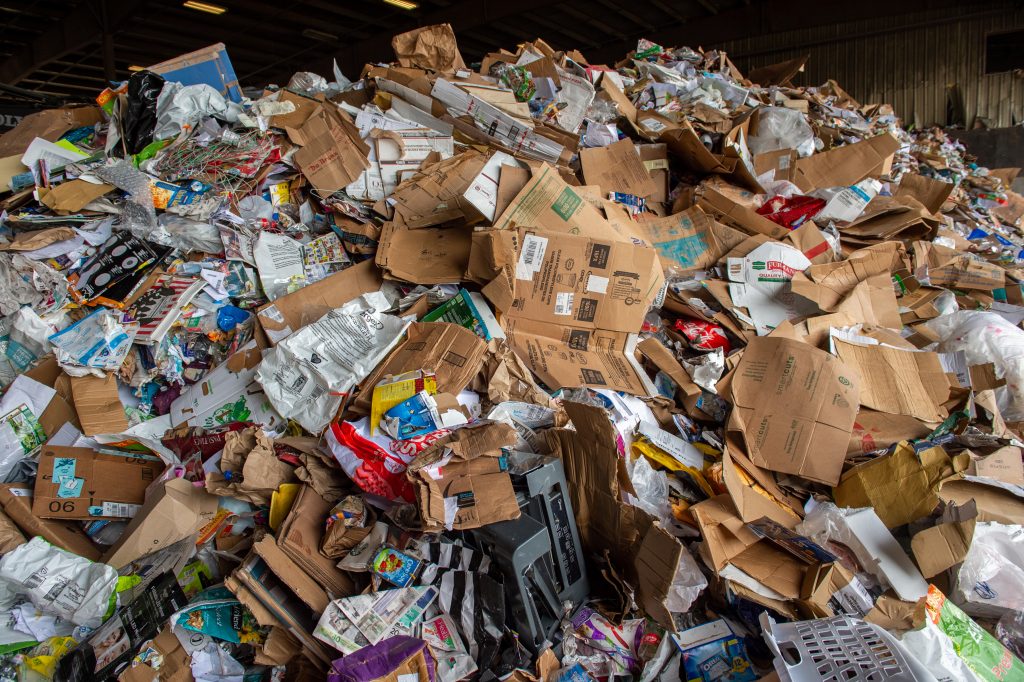
The Willimantic Waste Paper Company is a materials recovery facility (MRF) that sorts single stream garbage into its original components for recycling. It is not uncommon to find items thrown in the garbage that shouldn’t be there like electronics (foreground, center) and electrical wiring (top left.) Photo by Cloe Poisson (Courtesy CTMirror.org)
Pushed by haulers who didn’t want to run routes twice or purchase new trucks that could accommodate two streams of recycling, everything recyclable now goes into one bin.
And that gets us to today’s problems.
“People just assumed you could put anything in them,” said Sherrill Baldwin, an environmental analyst with the Department of Energy and Environmental Protection who does recycling education and outreach.
“Wish-cycling” – when people put things in their bins they think are recyclable — is what it’s often called. A recent composition audit conducted by Willimantic for the Southeastern Connecticut Regional Resource Recovery Authority (SCRRRA) showed trash residue in recycling is up 27% from 2016 to 2019 and now accounts for nearly 17% of the total volume, up from 11% in 2016.
And the glass that people used to return through bottle deposits are ending up there too, an unintended consequence of that nickel deposit proving to be no match for the convenience of throwing glass into the blue bin.
The result: the state’s bottle bill tracking shows a steady decline in the bottle bill redemption rate – now around 50%.
For recyclers like Tom DeVivo, the third generation in the family-owned Willimantic Waste, the extra glass is the bane of their existence. Glass slices up their sorting equipment, litters the ground and contaminates all the other recycling they sort to be purchased and processed.
The contamination from glass, food, trash and other items has shifted the economics of recycling. In recent years, the biggest purchaser of U.S. recycling was China, which historically turned the separated bales of plastic, paper, cans and more into raw materials for reuse.

Shards of crushed glass bottles bounce as they hit a pile as they fall from a conveyor belt at the Willimantic Waste Paper Company. Broken glass in single stream recycling can contaminate other recyclables like paper and cardboard, lowering their value. Photo by Cloe Poisson (Courtesy of CTMirror.org)
China finally put its foot down several years ago and instituted a new policy, called National Sword, in January 2018, that has cut off imports of most worldwide recycling. Hardest hit are plastic and paper, though China’s largest paper manufacturer – Nine Dragons – is now acquiring facilities in the U.S., including one in Maine that could provide a regional outlet.
It’s left MRF’s like the Willimantic Waste Paper Company scrambling for stateside buyers.
“I just shipped a load this morning to Alabama,” said DeVivo as his operation churned through the remnants of holiday excess last month. “Domestic markets have been stressed, because everyone else is starting to get into them. And it’s all about quality. At the end of the day, what we make has to be the best product that there is.”
The situation has upended pricing structures, which means towns that had been making a small amount of money off their recycling are now paying a lot to get rid of it. While municipalities are universally unhappy and, in some cases, financially stressed by this, making money from recycling was not always a given.
“I think the communities that continue to do source separation and dual stream are probably riding out the market a lot better than those who have pursued the mixed recycling approach,” Baldwin said, noting a similar market crash in 2008. “We rode it out. And we’re going to ride out this one too. Is it going to be a little bit longer than 2008? You bet. But that doesn’t mean it’s broken.”
But China hasn’t caused all of the problems. It’s arguable that Connecticut has brought a hefty chunk of them on itself.
Self-inflicted wounds
Many believe Connecticut has missed opportunity after opportunity to modernize its recycling systems. Lynn Rubinstein, who is the executive director of the Northeast Recycling Council, is one of them.
Rubinstein and others say Connecticut’s initial mistake occurred years ago – long before China cut off imports – when the state failed to recognize the economic development potential of recycling. One step that would help now, she said, is if the state committed to buying finished recycled products.
“Not realizing that environmental policies will induce business – I would say that’s an important missed opportunity,” Rubinstein said.
There’s very old regulation on Connecticut’s books, for example, that requires the state to buy paper that contains a small amount of recycled content, but it’s not enforced.
DeVivo agrees, and said Connecticut has also failed to create demand for its recycled products.
“That would change the dynamic and the metrics,” he said.
In other words, it’s important to create your own market. If the demand for a finished recycled item is there, companies that make it are more likely to set up shop. Connecticut doesn’t even typically use recycled glass as an aggregate in roads, a common practice in other states for decades. Instead, the glass is either shipped out of state to be used by another company, which derives the economic benefit, or – worse – sent to the landfill.
The one recycling specific in the governor’s bill is a section requiring the state Department of Energy and Environmental Protection to come up with initial recommendations on recycled content use.
Rubinstein said state-sponsored loans, technical assistance and grants would also incentivize recycling businesses. “If they had funding available for new businesses that either process or use post-consumer recycled content to build in Connecticut … you’d get people showing up on your doorstep, period.”
Just look at her most recent list of recycling businesses in the 11-state NERC regionthat use or process blue bin materials after they leave a MRF. Connecticut has barely a handful of companies – only Rhode Island has a worse track record. Pennsylvania has more than five dozen. Massachusetts and New York have a couple dozen apiece.
Strategic Materials in South Windsor is one of the few in Connecticut. A national company, it’s been in existence in some form for more than a century handling glass and now some plastic.
In Connecticut, the company takes only bottle bill glass, which is much cleaner than the glass from a MRF. Andrew Crowley, Strategic’s director of operations for the east coast, would like to see the bottle bill expanded to provide more material. “It ensures quality,” he said. “We’ve done a couple of pilots for curbside glass. It’s difficult to keep quality at a level we need.”
Most of Strategic’s ground glass, called cullet, is shipped out of state.
A savior on the horizon seems to be Urban Mining, which makes a substance called pozzotive from recycled glass, including items from recycling bins that tends to be more contaminated, that can be used as a partial cement replacement for concrete. The company has a plant under construction in Beacon Falls, after getting NIMBYed out of other locations, that should be open this summer.
Louis Grasso, one of the owners of Urban Mining, said at least one concrete operation has already committed to purchasing their product. “This is an opportunity to create an example of the circular economy for Connecticut,” Grasso said.
Connecticut has some paper and cardboard recycling, such as Atlantic Pulp in North Haven. The company makes molded pulp trays from clean cardboard clippings left before cardboard is made into a box and glue and other adhesives are added – keeping those out of the recycling stream, said owner Jim Bango.
But the state is missing out on all sorts of innovative recycling operations popping up elsewhere in the country – various types of lumber made from recycled plastics; companies like Preserve, in Massachusetts, that recycles plastic into everything from tableware to toothbrushes, or Fisher Recycling, in South Carolina, that makes countertops from recycled glass and presently has 30 cities identified as potential locations for new operations, according to owner Chris Fisher.
Big-time models
There are two examples of innovative recycling models that are repeatedly mentioned as ideas Connecticut should consider.
Oregon has the oldest bottle bill in the U.S., starting with beer and soft drinks in 1971 and now expanded to cover everything except liquor, wine, milk and milk substitutes. The deposit was raised to 10 cents to help push redemption rates above 80% and invest in the system.
“We don’t recycle here to make money,” said Peter Spendelow, a waste reduction specialist at the Oregon Department of Environmental Quality. “We do it to reduce environmental damage. And I can’t understand why the rest of the country hasn’t figured that out.”
That “rest of the country” would include Connecticut, which puts the non-refunded deposits from its bottle bill into the state’s general fund. Lately that’s been about $35 million a year.
Oregon’s model mimics a concept known as extended producer responsibility, EPR, in which the producer is responsible for end-of-life disposal. A beverage recycling cooperative has evolved in which distributors opened redemption centers that are fully staffed – which creates jobs – and use machines that divert the returns into a belt system, not the slow process crushing bottles used by Connecticut.
The system also allows people to sign up for an account and then buy bags that come with their account number on them. The containers go in the bag; the bag is dropped at a center or store and the account is credited by the next day. Some grocery stores are using the system for promotions – 12 cents back for every 10 cents in bottle redemptions as long as you use the money in that store.
“These sorts of innovations – they’ve made quite a difference,” said Spendelow. “They’ve pushed up the redemption rate, but what really pushed up the redemption rate was going to 10 cents.”
San Francisco is about to experiment with a higher-tech version of Oregon’s method – with bar codes on recyclable bags and mobile units that move around to accommodate a city clientele that can’t necessarily drive to a store.
And again, the government isn’t taking all the unclaimed money.
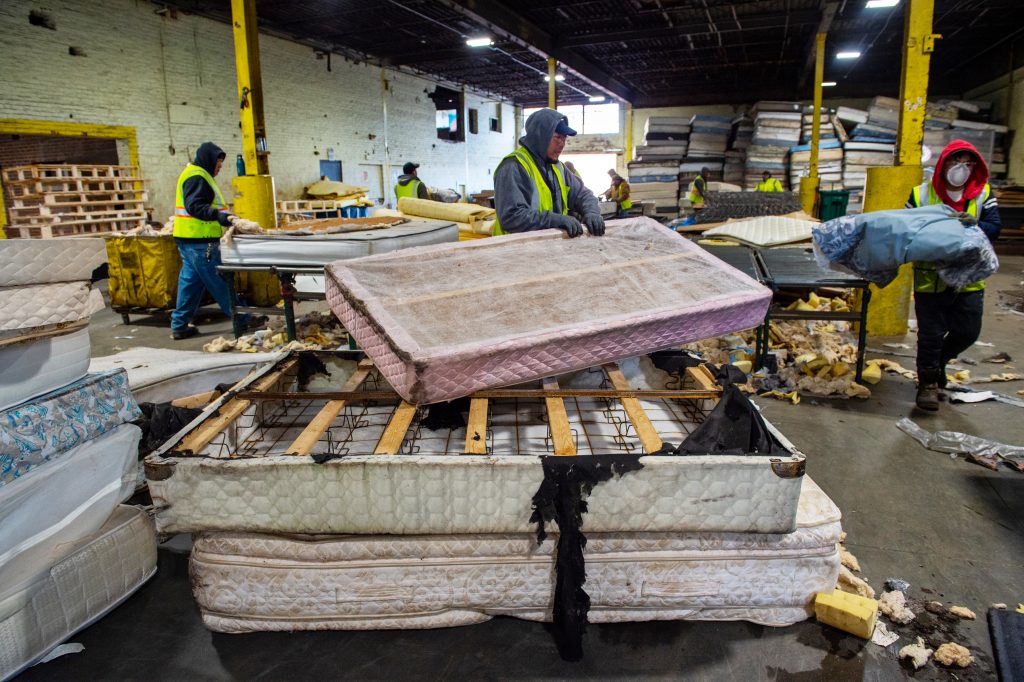
Workers at the Willimantic Waste Paper Company break down discarded mattresses into their separate components for recycling on a recent day at the facility. Connecticut mandates extended producer responsibility (EPR), a product stewardship concept, in which the producer is responsible for end-of-life disposal for paint and mattresses. Photo by Cloe Poisson (Courtesy of CTMirror.org)
Connecticut does have some experience with EPR. It was among the earliest states to mandate producers take responsibility for the disposal of paint and the first to embrace mattress recycling – something Willimantic handles in its complex. Both items were troublesome and expensive for municipalities, but not a big part of their waste stream.
The Canadian province of British Columbia is offering an example of how EPR can handle everyday items. Full producer responsibility is mandated for nearly two dozen stewardship organizations. The one that handles all residential packaging and paper – the items we put in blue bins here – calls itself Recycle BC. It’s a nonprofit, 100% designed, funded and operated by the packaging industry, and the only system of its kind in North America.
Even coffee pods – popular but too small for traditional recycling sorting machines – can be handled through Recycle BC. It saves money for municipalities, some of which are putting the taxes previously collected for recycling into new programs like collecting food waste or just lowering taxes.
In addition, Recycle BC has precipitated economic development as facilities for processing recyclables have cropped up in Canada, if not British Columbia itself.
“We make one of the key factors we are looking at when it comes to hiring a post-collection contractor a willingness to invest and innovate,” said David Lefebvre, a spokesman for Recycle BC. But “all of the decisions that we make, we make with an eye toward environmental outcomes.”
Homegrown solutions
The Saturday after Christmas was sunny but cold as vehicle after vehicle pulled into the Redding transfer station – don’t call it a dump – to disgorge all manner of holiday leftovers.
But different this year in the post-holiday cleanse was a big bin labeled “glass.” For the first time since the advent of single-stream recycling, Redding residents, mostly a haul-your-own-crowd, were being asked to separate it out.
It’s one of three communities in the 11-town Housatonic Resources Recovery Authority participating in a pilot project that began about a year ago to see if glass separation at trash drop-off sites will work well enough to eventually become mandated for curbside pickup, where available.
If you ask the folks dropping off materials about having to separate their glass you get shrugs. Vanessa McPherson and her husband are there with her car, his truck, and a lot of cardboard, plastic bags and batteries courtesy of their toddler’s Christmas haul.
“No big deal – just getting used to taking caps off,” McPherson said. “We try to be organized about separating it at home and then bringing it all here.”
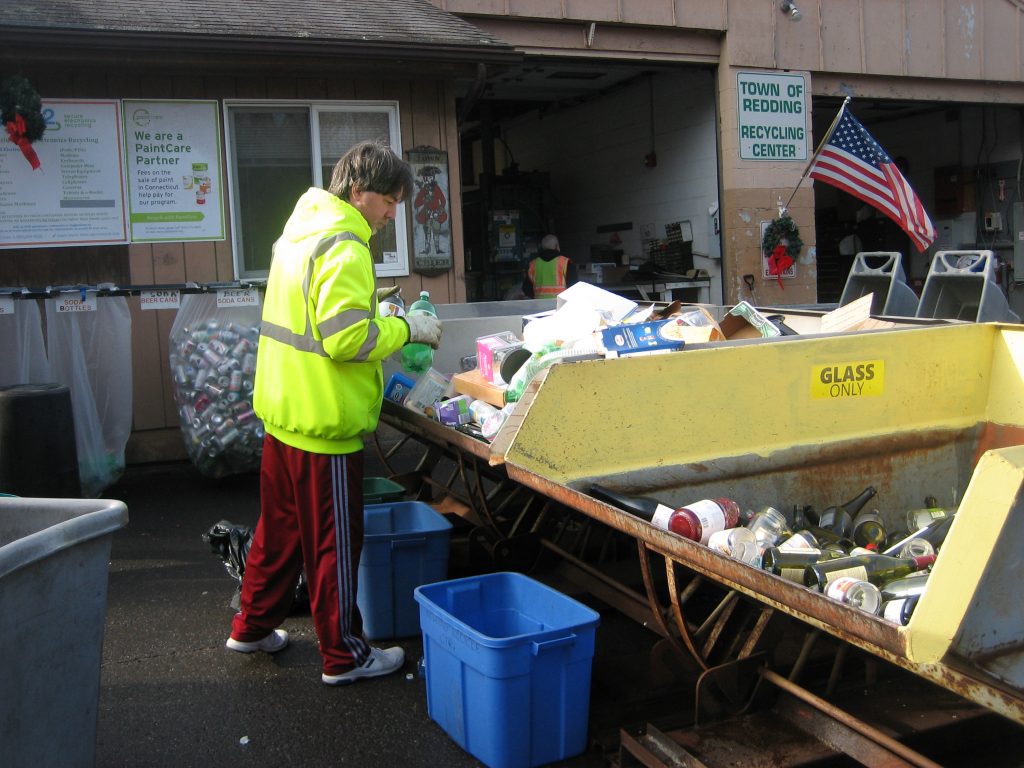
Recycling bins at Redding transfer station now has a separate one for glass. Photo credit: Jan Ellen Spiegel, CTMirror.org
Jennifer Heaton-Jones, HRRA’s executive director, who came up with the idea, said the new system has had a few growing pains. The plan to bring glass to Strategic Materials fizzled when loads were rejected because they weren’t clean enough.
For now it’s going to HQ Landscaping in Southington, which is crushing it to make sub-base aggregate stone for drainage. But when Urban Mining is up and running, that’s where the glass is slated to go.
Redding serves as an example of how recycling can be creative and useful. Never mind the jars of candy canes and dog treats the staff at the transfer station keep out for Redding residents; it also has two sheds of used items where residents can pick up and drop off as needed, offering yet another way to keep items out of the waste or recycling stream.
“Repurposing” is what Howard Schloss calls it. He’s built the better part of a chicken coop and fencing around a vegetable garden from items found here. He’s outfitted his kids’ apartments with everything from dishes to furniture and found gifts and supplies.
And the glass separation? “No big deal,” he said.
In Waterbury, C.J. May, the city’s refuse/recycling coordinator for the last five years, has taken a more practical approach to recycling. It had been largely ignored in this economically challenged city that is now paying $75 a ton to get rid of recycling instead of the $4.25 they used to make.
Using a grant from the Closed Loop Fund – a reference to the goal of recycling – he purchased 95-gallon recycling carts, plastered them with full-color labels in English, Spanish and pictures and went to work educating residents on how to recycle properly.
Carts with improper items get “oops” tags, though not fines, and carts filled correctly are noted too. “I actually had a special tag printed up, it’s a green star tag,” May said. “It’s the opposite of an ‘oops’ tag. It’s good job – you did a good job recycling.”
“If I just say you better put the cans and bottles here and the food waste over there and walk away, well, that’s just a mandate and Americans hate to be told what to do,” he added.
Now what?
Some Connecticut municipalities say that recycling is no longer worth their while, but Kristen Brown disagrees.
“It will be,” said Brown, vice president waste reduction strategy at the consultant group Waste Zero, which has been working with individual cities and towns here as well as the state as whole.
She says the blame game she hears in meetings needs to stop.
“Think about ideas for improving the bottle bill like they do in Oregon. Or focus on the hard-to-recycle-plastic material because it’s currently contaminating the recycling,” she suggested. “Now’s the time to move into recycling and think outside the box and that might create some more local jobs and boost the economy.”
That includes taking advantage of what’s already here – operations like Simple Recycling, which began curbside pickup of textiles a little over two years ago. They pay municipalities for the materials, yet fewer than 30 have signed up.
The idea of regional collaborations is often mentioned – and is noted in the governor’s bill. The governor’s legislation doesn’t prescribe any specific programs. Instead it authorizes a process for requests for proposals through DEEP.
Expanding producer responsibility a la British Columbia is another idea. That EPR has the potential to change the economic dynamic of waste haulers and MRFs is not lost on DEEP Commissioner Katie Dykes, who admits the state is at an inflection point with its waste and recycling. But, she said, whatever happens needs to be both cost effective and aligned with environmental goals.
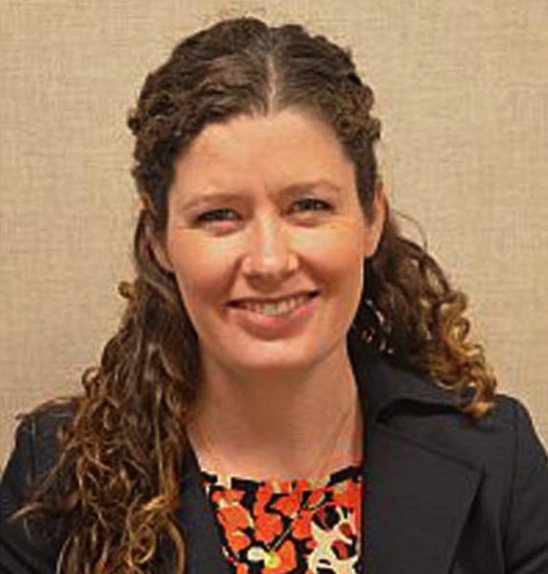
Katie Dykes. Courtesy photo
She chooses her words carefully. “It has a lot of implications for the system we have today, not just for manufacturers of products, but also those who have made investments here in Connecticut,” she said. “It’s very important as we look at ways to capture this opportunity or make progress in EPR that we have a big table and we are really sensitive to and listening to all the different stakeholders.”
The governor’s bill makes no mention of the bottle bill or its potential expansion – something that surfaces as stand-alone legislation almost every year.
People like DeVivo at Willimantic – who stand to lose business if their waste and recycling streams decrease – are OK with expanding the bottle bill to get more glass out of their system.
“I’m not going to complain. I’m not upset with that on the glass side. I do complain if you take away the plastics and aluminum because that’s where the money is,” he said.
Aresimowicz is on the fence about bottle bill expansion. “I don’t know, I don’t know,” he said. “I’ve been reluctant to do it. But if we’re pulling glass out and handling glass differently, would I be open to more expansion when it comes to plastic bottles? Maybe. Yes.”
“One hundred sixty-nine municipalities and us being the land of steady habits has really limited our ability to make changes,” he said. “I’m sick and tired of hearing ‘oh we don’t do that here – that’s not how we’ve ever done it.’”
Reprinted with permission of The Connecticut Mirror. The author can be reached at [email protected].
Like what you see here? Click here to subscribe to We-Ha’s newsletter so you’ll always be in the know about what’s happening in West Hartford!


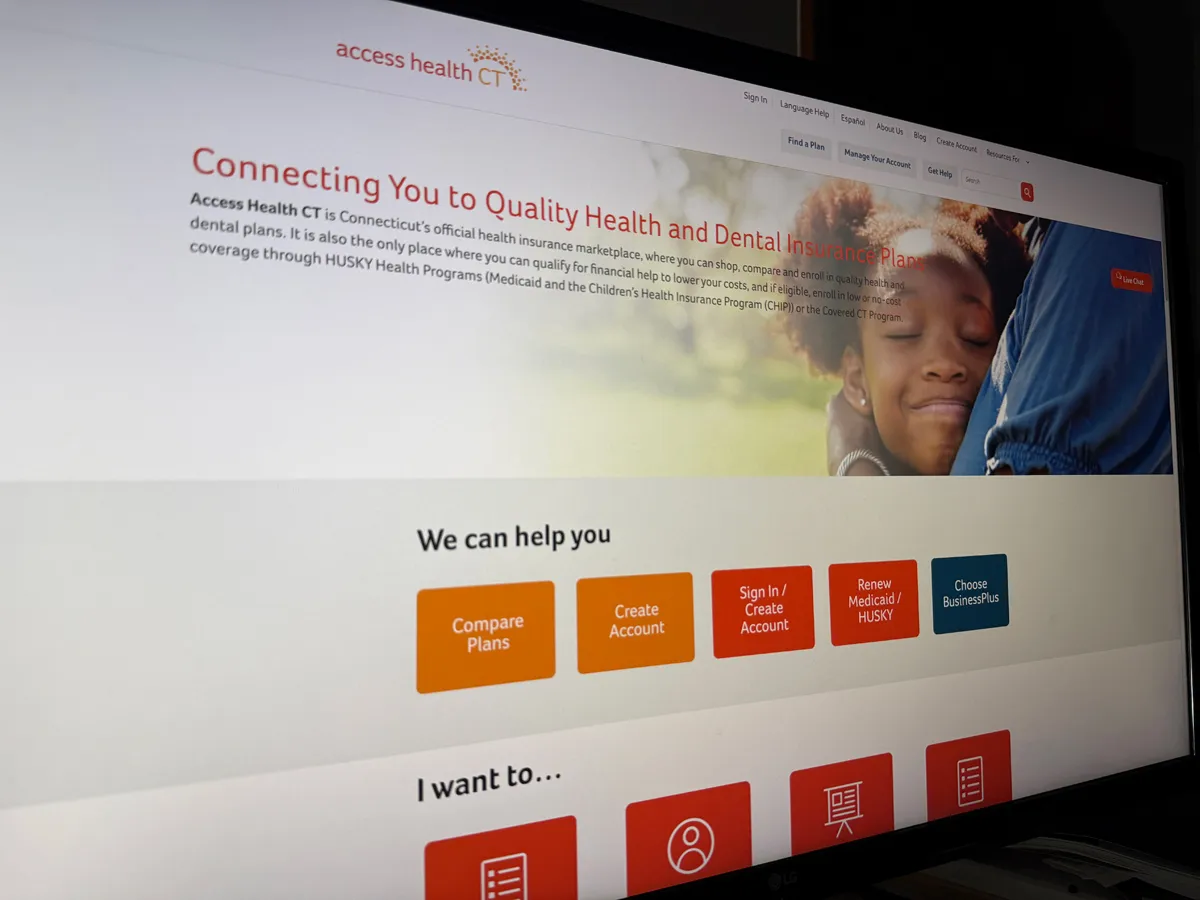

Thank you for this really informative piece.
All I want to add is a reminder about food waste and a strong recommendation for BlueEarthCompost.com